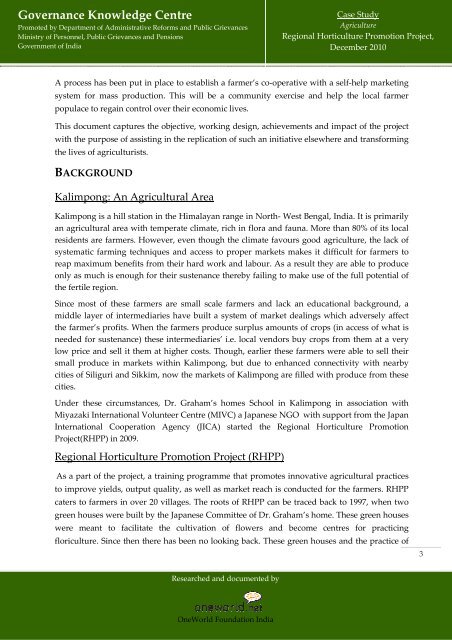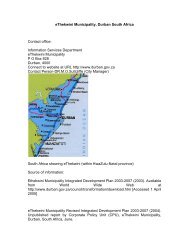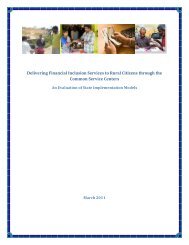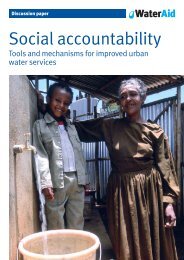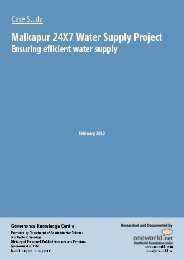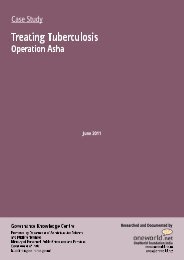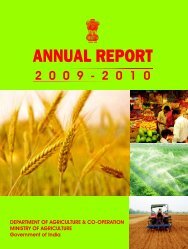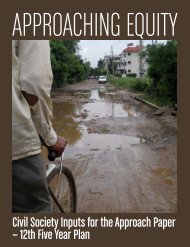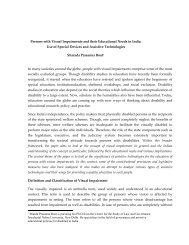See full case study - Governance in India
See full case study - Governance in India
See full case study - Governance in India
Create successful ePaper yourself
Turn your PDF publications into a flip-book with our unique Google optimized e-Paper software.
<strong>Governance</strong> Knowledge CentrePromoted by Department of Adm<strong>in</strong>istrative Reforms and Public GrievancesM<strong>in</strong>istry of Personnel, Public Grievances and PensionsGovernment of <strong>India</strong>Case StudyAgricultureRegional Horticulture Promotion Project,December 2010Transparency and AccountabilityA process has been put <strong>in</strong> place to establish a farmer’s co-operative operative with a self-help market<strong>in</strong>gsystem for mass production. This will be a community exercise and help the local farmerpopulace to rega<strong>in</strong> control over their economic lives.This document captures the objective, work<strong>in</strong>g design, achievements and impact of the projectwith the purpose of assist<strong>in</strong>g <strong>in</strong> the replication of such an <strong>in</strong>itiative elsewhere and transform<strong>in</strong>gthe lives of agriculturists.BACKGROUNDKalimpong: An Agricultural AreaKalimpong is a hill station <strong>in</strong> the Himalayan range <strong>in</strong> North- West Bengal, <strong>India</strong>. It is primarilyan agricultural area with temperate climate, rich <strong>in</strong> flora and fauna. More than 80% of its localresidents are farmers. However, even though the climate favours good agriculture, the lack ofsystematic farm<strong>in</strong>g techniques and access to proper markets makes it difficult for farmers toreap maximum benefits from their hard work and labour. As a result they are able to produceonly as much is enough for their sustenance thereby fail<strong>in</strong>g to make use of the <strong>full</strong> potential ofthe fertile region.S<strong>in</strong>ce most of these farmers are small scale farmers and lack an educational background, amiddle layer of <strong>in</strong>termediaries have built a system of market deal<strong>in</strong>gs which adversely affectthe farmer’s profits. When the farmers produce surplus amounts of crops (<strong>in</strong> access of what isneeded for sustenance) these <strong>in</strong>termediaries’ i.e. local vendors buy crops from them at a verylow price and sell it them at higher costs. Though, earlier these farmers were able to sell theirsmall produce <strong>in</strong> markets with<strong>in</strong> <strong>in</strong> Kalimpong, but due to enhanced connectivity with nearbycities of Siliguri and Sikkim, now the markets of Kalimpong are filled with produce from thesecities.Under these circumstances, Dr. Graham’s homes School <strong>in</strong> Kalimpong <strong>in</strong> association withMiyazaki International Volunteer Centre (MIVC) a Japanese NGO with support from the JapanInternational Cooperation Agency (JICA) started the Regional Horticulture PromotionProject(RHPP) <strong>in</strong> 2009.Regional Horticulture Promotion Project (RHPP)As a part of the project, a tra<strong>in</strong><strong>in</strong>g programme that promotes <strong>in</strong>novative agricultural practicesto improve yields, output quality, as well as market reach is conducted for the farmers. RHPPcaters to farmers <strong>in</strong> over 20 villages. The roots of RHPP can be traced back to 1997, when twogreen houses were built by the Japanese Committee of Dr. Graham’s home. These green houseswere meant to facilitate the cultivation of flowers and become centres for practic<strong>in</strong>gfloriculture. S<strong>in</strong>ce then there has been no look<strong>in</strong>g back. These green houses and the practice of3Researched and documented byOneWorld Foundation <strong>India</strong>


